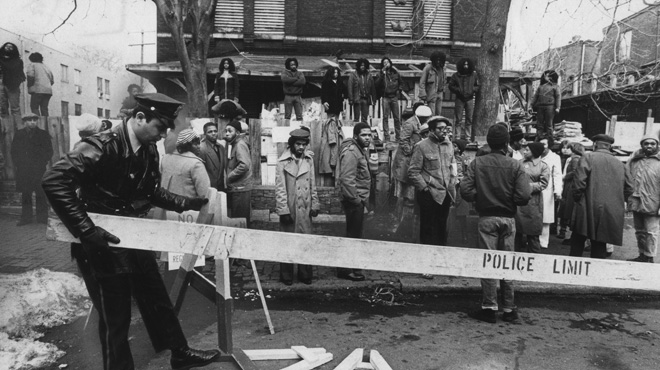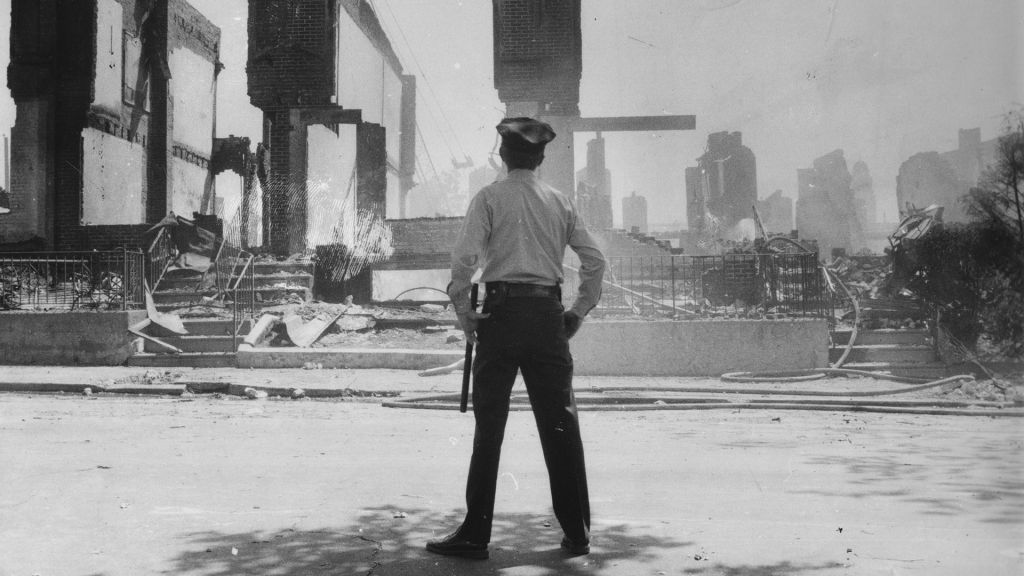
MOVE members and police during the 1978 confrontation outside MOVE headquarters.
It’s the week of the 29th anniversary of the MOVE bombings, and for those who were in the middle of it and are still with us, the memories of those tragic events still linger all these years later. As the haunting story unfolds in Jason Osder‘s Let the Fire Burn, you may be curious as to what became of some of the people involved.
[Much of the information cited here and linked is thanks to the Philadelphia Inquirer‘s 25th anniversary coverage.]
[Update (2019): Read this oral history of the 1985 bombings on Vox.]
The saddest news of all is the very recent, sudden death of Michael Ward, aka Birdie Africa, who was the only child to survive the MOVE bombing. His mother Rhonda Africa was killed in the tragic event. Ward, only 41 at the time of his death, was on a cruise in the Caribbean with his family. Ward had fought through the pain of the awful events from his childhood to restart his life; from the New York Times obituary:
Yet after years of rehabilitation from injuries physical and psychological, he graduated from high school, served in the Army, became a father and made a career as a long-haul trucker and a barber.
Ramona Africa, the one adult survivor of the MOVE fire (and whom has an interesting quote of condolences in that article about Ward linked above), served seven years in prison on riot charges stemming from the 1985 confrontation. She later sued the city and pocketed part of a $1.5 million civil-rights judgment. She still lives in Philadelphia, and still upholds MOVE’s beliefs and causes. She said the group’s priority is still the “unrelenting fight for our brothers and sisters who’ve been in prison since 1978.”
Meanwhile, she travels around the world – she’s been to Cuba, South Africa, and several European countries – spreading the message of John Africa. And as for MOVE itself, a current website shows the group to be still active.
Here’s Ramona Africa a few years ago talking to Philadelphia TV current affairs host Art Fennell, giving her perspective on what happened in that city in the late ’70s and early ’80s.
Wilson Goode was mayor of Philadelphia for just over a year before being part of the MOVE maelstrom — his infamous words inspired the title to the film — but despite the controversy and the changing tide of public opinion about it, was re-elected mayor in 1987. But an attempt to remain in the mayoral seat in 1991 was defeated as he was succeeded by former district attorney Ed Rendell. Some would argue that Goode’s post-mayoral career — in which he’s worked in education and as a leader of prisoner outreach — initiated more positive change than as mayor; he’s currently a senior adviser to Public/Private Ventures where he oversees Amachi, a mentoring program for children of incarcerated parents. He was recently awarded the Purpose Prize, a $100,000 award given to exceptional individuals over age 60 who are working to address critical social problems. [More on Wilson Goode in 2010.]
Here is an NBC News piece on Goode’s embattled mayoral reign, as he ran for re-election in 1987 (and in which he talks about the MOVE bombings):
As seen in the film, Police officer James Berghaier was one of the few law enforcement officers who clearly tried to do good in the MOVE conflagration when he risked his life to save young Birdie Africa, and is still haunted by the memory today. From that Phily.com piece:
2010: Berghaier, 60, has long struggled with the guilt he feels about not being able to save the other MOVE children. (He wasn’t aware they were there at the time.) He retired from the police force shortly after the MOVE confrontation and later divorced his wife. He bounced around to various jobs over the years, including working as a bar manager and as a janitor. Remarried, he lives in Northeast Philadelphia and works for a nonprofit agency.
Berghaier doesn’t think or talk about MOVE every day, but when he does, it clearly upsets him.
“I don’t act like this every day,” he said after getting teary during his interview. “I’ll probably find peace when I pass.”
Officer James Berghaier
And what of the townhome itself, the site of MOVE’s home and the bombing? 6221 Osage Avenue has had a difficult history, to say the least. From a 2005 USA Today article (and, sadly, as far as we can tell, very little has changed — see Google Maps, as of 2012):
Today, the site of the bombed house, 6221 Osage, is occupied by the police Civil Affairs Unit. The city rebuilt Osage Avenue, but the construction was so shoddy that years of repairs failed to fix the homes. Finally, the city condemned them and offered owners $150,000. Many took the buyout, but 24 families went to federal court. The city is appealing the judgment.
Explore more:
NPR story: ‘Let The Fire Burn’: A Philadelphia Community Forever Changed
“MOVE Bombing Still Leaves Philadelphia Scarred” [CBS News]
A lively post-film panel discussion with Ramona Africa, an emotional Officer James Berghaier, and filmmaker Jason Osder:
Trailer for Let the Fire Burn:
https://www.youtube.com/watch?v=DVczmrZgB2E

